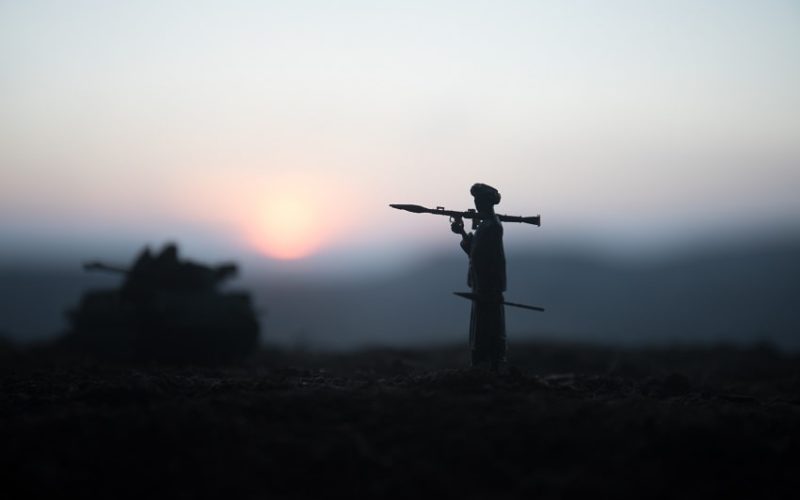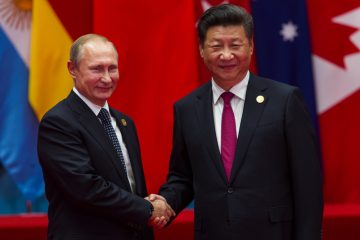Written by : : Mohammad Qais Rahmani
Photo : Shutterstock.com
On April 14, 2021, the U.S. President Joe Biden announced the withdrawal of the remaining 2,500 American troops from Afghanistan by 11 September. The date is very significant as it will mark twenty years of the al-Qaeda attacks that triggered America’s invasion in Afghanistan. However, things are happening more rapidly than expected. By now It is clear that the American administration wants to get out of Afghanistan as soon as possible. The departure of the US troops from Bagram Airbase on July 2 in the darkness of the night without informing the base’s new Afghan commander has put a serious question mark before the future of the Afghanistan state in a context where the Taliban are trying to expand their control over Afghanistan with coordinated attacks, and the peace process initiated between the Taliban and the Afghan government is not going anywhere. The surprising fact is that Bagram contains a prison, and there are reportedly up to 5,000 Taliban prisoners detained in the facility.
Background
The U.S.-Taliban relationship can be summed up as following: partnership-hostility-settlement. They were partners, before the establishment of the Taliban movement, when Mullah Omar was fighting against the soviet union occupation of Afghanistan. However, in 1996 when Mullah Omar “founded” the Taliban movement and seized power by establishing the Islamic emirate of Afghanistan, the United States obviously kept its distance and did not recognized the Taliban government because of their severe interpretation of Islam and their links with international terrorist groups. The direct U.S. involvement in Afghanistan started in 2001 when the Taliban rejected the U.S. ultimatum to hand over the al-Qaeda leaders who were behind the 9/11 terrorist attacks in New-York and Washington. In October 2001 the United States invaded Afghanistan under the UN resolution 1378, in order to drive the Taliban from power and eliminate the al-Qaeda safe havens inside Afghanistan. After the fall of the Taliban government, a conference was held in Bonn under the UN supervision to establish a new government.
Being ousted from power, the Taliban did not recognize the “democratic” alternative Afghan government following the invasion and declared “jihad” against the foreign presence as well as against their supported government. The conflict continued for almost twenty years with a heavy cost to all sides and turned out as the longest war in U.S. history. Thus the U.S. war strategy in Afghanistan has changed and been replaced by peace diplomacy.
After long negotiations, finally, the U.S.-Taliban signed a draft bilateral agreement “for bringing peace in Afghanistan” on 29 February 2020, in Doha, with the mediation of the Qatari government. Although the media and analysts from many countries called it a “peace agreement,” it was not. It should be regarded only as the first step in a long process for bringing peace, which is still elusive in Afghanistan. In this draft agreement, the United States agreed to withdraw 8,600 troops within 135 days and complete a full withdrawal within fourteen months. In return, the Taliban guaranteed to prevent territory under their control from being used by terrorist groups, including al-Qaeda, and enter into negotiations with the Afghan government in March 2020.
However, the realisation of the peace process has proved difficult. Although there is a ceasefire between the Taliban and the foreign forces in the draft agreement, the Taliban continue their fight against the Afghan government. The issue has became more contentious as the Afghan government is not a signing party of the agreement and that has provided the Taliban an extra leverage from the very beginning of the negotiations. In fact, the Taliban consider it as a win over the American invaders.
Moreover, the spread of the coronavirus pandemic worldwide complicated things further. The U.S was hit hard with a major health crisis. And then came the change in US diplomatic leadership as the outcome of the presidential election in November 2020.
Since the Biden administration took charge in January 2021, it has put its primary focus on America’s economic revival and resolving domestic issues. On the other hand, it soon found itself caught up in the legacy of the previous Trump administration as the May 1 deadline for withdrawal of troops was approaching. As the Biden administration began reviewing the agreement, the Taliban called on the US to implement the Doha accord fully, saying it is committed to secure US security interests in the country.
Peace talks between the Taliban and the Afghan government resumed in Doha in late February 2021, but negotiations disrupted due to a disagreement on the timing of the release of five thousand Taliban prisoners. The Taliban expected the prisoners to be released before talks can begin, while the Afghan government had plan to release the prisoners only after the negotiations start. Above all, the fragility of the Afghan government due to rifts between President Ashraf Ghani and his main rival and current Chief Executive Officer Abdullah Abdullah, after the disputed result of September 2019 election had further complicated prospects of a deal. The Taliban continued to carry out attacks on Afghan government targets, making territorial gains.
Some fact checks :
War in Afghanistan is of course influenced by internal and external factors. These factors have had an important role for the perpetuation violence in Afghan society throughout its history. The involvement of foreign powers in Afghanistan had and still has different motivations and has led to diverse consequences during the past four decades. These foreign interventions have occurred according to the dynamics of changes or continuity in regional power-play politics, to the dynamics of the society and politics in Afghanistan and to the transformation process within the country. Moreover, during these four decades, the continuation of war and internal problems became somehow entangled with the interests of outsiders and have added to the complexity of the internal and external factors. Foreign interventions during the past four decades have always been raised as one of the major causes of the war and violence and an obstacle to peace and stability in the country. Afghanistan, from the beginning of the 1800’s, has been a buffer state between the two world powers: Great Britain and czarist Russia, and even after the demise of these world powers status, they could not free themselves from the shadows of the regional power-play.
Thus, the new century saw Afghanistan more fragile than ever and facing new challenges such as Islamic fundamentalism that confronted the whole world, and turned Afghanistan into a proxy battlefield by its neighbours and other countries far away: China, Saudi Arabia, and the U.S. At this juncture, Afghanistan became the violent backyard of its northern and western neighbours and was seen as offering strategic depth to its southern and eastern neighbor, Pakistan. After 2001 when Afghanistan became the center of international attention and support, however, neighbouring countries continued their intervention in a different way, such as playing a double game of supporting proxy political parties and armed groups, thus nullifying much of the progress being made by the international community and the new “democratic” government. Nevertheless, rampant corruption affected the functioning of the administration in all sectors, especially in rural Afghanistan. The government, while enjoying the strong and inclusive support of the international community, neglected to take full advantage of the new opportunities and to improve the situation of Afghanistan by defining, planning and following a new strategy for its foreign policy. In fact, the foreign policy of Afghanistan post Soviets and post Taliban failed to redefine the position of the country from a land of war to a land to regional integration and economic cooperation.
As a result, after four decades, Afghanistan still remained vulnerable to foreign interventions. Despite the international presence and support of a new political system, the complexity and the intensity of regional competition escalated. Considering the geographical location of Afghanistan, the interests of these regional countries are dependent on the continuation of war in Afghanistan. Differences between Kabul and Islamabad over the Durand line, water-sharing issues, and the security approach of Pakistan for Afghanistan largely defined by its rivalry with India are major causes for interventions from Islamabad. the ongoing ideological competition between Iran and Saudi Arabia, the competition between powers such as China and America over the resources in the Middle East and the competition between Russia and America over the political and economic influence in the Middle East and South Asia, are other causes for interests and intervention, as Afghanistan is located at the center of these regions. It is helpful to recall that all of these factors and issues were once called the “great game.”
What are the current challenges?
The “great game” has become even more complex in our modern times with the advent of international terrorist groups. This new factor is related to the weaknesses and inefficiency of many regional governments and the presence of non-state actors such as terrorist and extremist groups. These groups benefit from the existing tensions between states and seize new opportunities and grounds opened by the government’ failure, drawing the entire region into more turmoil and chaos. In this chaos, terrorist groups, some of them emerging as assets of one of the regional or global powers do not recognize the borders and take advantage of the inefficiency of the governments. Following the defeat of the Islamic State (ISIS) in the middle east countries, particularly Iraq and Syria, there is a new growing fear that these groups might withdraw or transfer to South Asia and Central Asia especially to Afghanistan.
There are two hypotheses on the future of the Afghan peace process. The first one is : as the Taliban achieved a strong position during the peace talks with the U.S. and they had time to negotiate with the U.S. regional competitors, the collapsed peace process would plunge the country in civil war which will be used as a proxy field of the great powers causing more regional instability.
The second hypothesis involves negotiations to build the future government of Afghanistan. The intra-Afghan talks, complicated as they could be, should also discuss the consociational idea of power sharing among diverse groups. The Taliban do not recognize the Afghan government, calling them the Kabul administration. The Taliban also do not accept the constitution of Afghanistan, under which the current Afghan government was recently elected. Thus, a deal with the Taliban means the end of the Afghan government and the establishment of a new administration and new constitution in which all sides can see themselves.
This hypothesis may raise serious problems for the new generation of the Taliban who has always been in war and who lacks the education permitting its assimilation in a modern civil society. In a democratic government they would have difficulty competing with the formal educated people for careers and status, thus if the young generation of the Taliban put their arms down it means that they accept their perceived “inferiority” vis-à-vis educated city dwellers, which is generally unacceptable to them. So the risk is that they would once again pick up their arms and join other terrorist organizations like Islamic State of Khorasan (IS-K). Therefore, the future of the Afghan civilian population, especially women and minorities, remains extremely uncertain which will result in forced internal displacement and high rate of migration towards the western Europe.
(The views expressed in this article are the author’s own and do not necessarily reflect Multidimension’s editorial stance.)
About the author :
Mohammad Qais Rahmani
Former diplomatic journalist at Ariana News and actually PhD candidate at CEDS University in Paris




